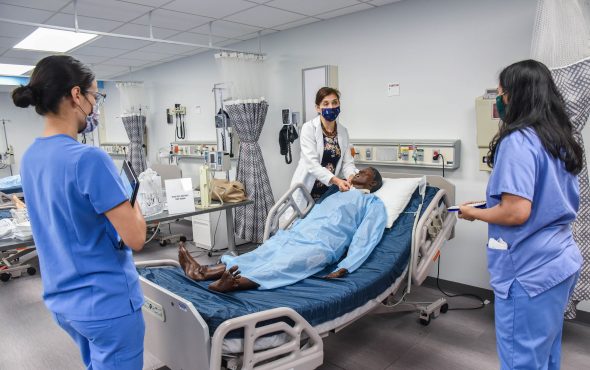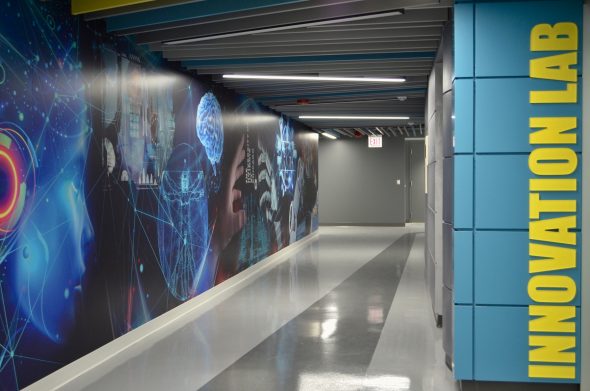Simulation labs help learners, educators pivot during COVID-19 pandemic
From adapting existing simulation laboratories to opening a state-of-the-art surgery training laboratory, University of Illinois Chicago is at the forefront of virtual health learning, especially during a global pandemic.
One year ago, UIC celebrated opening three health care simulation centers, adding spaces to facilitate over 50,000 hours of hands-on learning for thousands of health care learners. Stocked with advanced and computerized manikins, as well as specially trained actors, these simulated environments stood ready to educate thousands of learners.

In March, a group of anesthesiologists had just completed the first day of training on how to properly use personal protective equipment, PPE, in the Simulation and Integrative Learning Institute in the College of Medicine, SAIL.
“Then the COVID restriction orders came down from the governor’s office,” said Christine Park, professor of anesthesiology and medical education and Director of SAIL. “Everyone in health care simulation had to adapt instantaneously to a completely new landscape.”
“The College of Nursing decided early on that we couldn’t work in our sim lab assessing patients and while maintaining a distance of 6 feet,” said Leah Burt, director of UIC’s adult-gerontology primary care nurse practitioner program. “We decided to lean into it. We decided to make it work for us.”
Leaning into it meant pivoting from using standardized patients — actors in a clinical lab — to standardized patients online. Learning telehealth competencies are important during the pandemic and will continue to be so in the future, they embraced it by creating telehealth sim labs. In addition to online lectures and exams, learners across the health sciences now participate in telehealth simulations.
The standardized patients know how to ask questions and deliver feedback about how the learners made them feel emotionally. In turn, students are instructed on how to talk to patients in a way that helps them describe their symptoms.
“Students are expected to conduct a true telehealth visit with a patient, take a patient history, assess them and come up with a treatment plan just as you would if you were a nurse practitioner in a hospital or clinic,” Burt said.
Nurse practitioner students also will do a short clinical rotation with a nurse practitioner who is conducting telehealth visits.
The sim lab experience is different for medical students and their educators as well. While learners have had to modify how they perform physical exams virtually, the actors hired as simulated patients have had to adapt their ailment portrayals as well as how they assess and coach the learners.
Standardized patient and actor Sarah Schol said the online visits pose several new challenges, such as having to account for differences in eye contact on camera, as well as the extra steps learners need to take.
“There’s a telehealth simulation checklist for students … ‘Is my space clear?’ ‘Is their space clear of other people?’ ‘Let me know what to do if their internet goes out, or the sound goes out,’ Skol said. “It’s really good practice for what telemedicine will be like.”
Virtual learning has taken new meaning during a time when telehealth increasingly has become standard practice.
“In the beginning of COVID, we felt like we were being forced into a situation and having to accept it. Little did we know this would create an opportunity to give our students skills they will need,” said Laura McKenzie, assistant director of SAIL.

Planned long before the global pandemic, the Surgical Innovation & Training Laboratory (SITL), a state-of-the-art venue for surgical training, research and innovation, is the penultimate sim lab.
The new, 16,000-square-foot, $8.8 million facility has been the result of years of joint planning led by UIC, the University of Illinois College of Medicine and UI Health. The SITL, which opened Sept. 15, will provide hands-on training for all the surgical disciplines, with a particular emphasis on the microsurgery and robotic surgery fields. Surgeons will have access to modern surgical training tools, including several robotic units, with direct feeds from the operating room transmitted to a large classroom area with three modular units that can be combined for a total maximal capacity of up to 200 learners once COVID restrictions are lifted.
Dr. Pier Giulianotti, professor of surgery and chief of the division of general, minimally invasive, and robotic surgery, said the lab’s simulation capabilities support the dual mission of education and research.
“Students and residents can sit down and counsel, and they can try operations without having a patient underneath and are able to repeat the steps of a perfect procedure without damaging or hurting anybody,” Giulianotti said.
General surgery resident Dr. Christina Warner likens the SITL experience to a driver’s education class.
“You first sit down and learn the basics, the rules of the road, how to respect the instruments, how to respect the patients when you’re utilizing the instruments, how to position yourself in relation to the patient when starting the operation,” Warner said. “In the laboratory setting, the resident learns how to translate what they’re seeing on the screen to what they’re actually doing within the patient’s body. For obvious reasons, it’s best not to do that while you’re actually operating on a patient.”
Categories
Campus, Health Sciences Colleges, Staff, Students
Topics
Christine Park, College of Medicine, College of Nursing, Leah Burt, nurse practitioner, Pier Giulianotti, SAIL, sim lab, simulation and Integrative Learning Institute, simulation lab, SITL, Surgical Innovation & Training Laboratory, telehealth, UI Health
